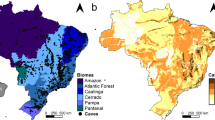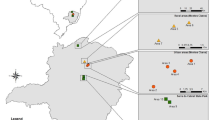Abstract
This work is concerned with elucidating competitive interactions between two neotropical ants, Solenopsis geminata and Pheidole radoszkowskii, focusing on their foraging behavior. When released from competition from P. radoszkowskii, S. geminata increased its foraging activity. On the other hand, when released from competition from S. geminata, P. radoszkowskii did not respond, demonstrating asymmetric competition between the two species. Foraging experiments showed that P. radoszkowskii is more efficient at finding food resources, whereas S. geminata is better at defending the resources once they are encountered. These differences in foraging behavior appear to permit the coexistence of these two species. The practical implications of the results for the management of ant communities in tropical agroecosystems is discussed with respect to the potential use of ants as natural enemies.
Similar content being viewed by others
References
Benítez J, Perfecto I (1990). Efecto de diferentes tipos de manejo de café sobre las communidades de hormigas. Agroecol Neotropic 1: 11–15
Bhatkar AP (1988). Confrontation behavior between Solenopsis invicta, S geminata, and other Florida ant species. In: Trager JC (ed) Advances in myrmecology. E. J. Brill, Leiden, pp 445–464
Brown JH, Reichman OJ, Davidson DW (1979). Granivory in desert ecosystems. Annu Rev of Ecol Syst. 10: 201–227
Carroll CR, Jansen DH, (1973) Ecology of foraging by ants. Annu Rev Ecol Syst 4: 231–257
Carroll CR, Risch SJ (1984) The dynamics of seed harvesting in early successional communities by a tropical ant, Solenopsis geminata. Oecologia 61: 388–392
Hansen SR (1978) Resource utilization and coexistence of three species of Pogonomyrmex ants in an Upper Sonora grassland community. Oecologia 35: 109–117
Hölldobler B (1981) Foraging and spatiotemporal territories in the honey ant Myrmecocystus mimicus Wheeler (Hymenoptera: Formicidae). Behav Ecol Sociobiol 9: 301–314
Kidd KA, Apperson CS (1984) Environmental factors affecting relative distribution of foraging red imported fire ants in a soybean field on soy and plants. Agric Entomol 1: 212–218
Levings SC, (1983) Seasonal, annual, and among-site variation in the ground and community of a deciduous tropical forest: some causes of patchy species distributions. Ecol Monogr 53: 435–455
Levins RL, Pressick M, Heatwole H (1973) Coexistence patterns in insular ants. Am Sci 61: 463–472
Logfren CS, Banks WA, Glancey BN (1975) Biology and control of imported fire ants. Annu Rev Entomol 20: 1–29
Nestel D, Dickschen F (1990) The foraging kinetics of ground ant communities in different coffee agroecosystems. Oecologia 84: 58–63
Perfecto I, (1990) Indirect and direct effects in a tropical agroeco-system: the maize-pest-ant system in Nicaragua. Ecology 71: 2125–2134
Perfecto I, (1991a) Ants (Hymenoptera: Formicidae) as natural control agents of pests in irrigated maize in Nicaragua. J Econ Entomol 84: 65–70
Perfecto I, (1991b) Dynamics of Solenopsis geminata in a tropical fallow field after ploughing. Oikos 62: 139–144
Perfecto I, and A. Sediles, 1992. Vegatational diversity, ants (Hymenoptera: Formicidae), and herbivorous pests in a neotropical agroecosystem. Environ Entomol 21: 61–67
Perfecto I, Vandermeer JH, (in press) Understanding biodiversity loss in agroecosystems: reduction of ant diversity resulting from transformation of the coffee ecosystem in Costa Rica. Trends Agric Sci Entomol
Risch SJ, (1981) Ants as important rootworm eggs in the neotropics. Journal of Econ Entomol 74: 88–90
Risch SJ, Carroll CR (1982a) The ecological role of ants in two Mexican agroecosystems. Oecologia 55: 114–119
Risch SJ, Carroll CR (1982b) Effect of a keystone predaceous ant, Solenopsis geminata, in a non-equilibrium community. Ecology 63: 1979–1983
Saks ME, Carroll CR (1980) Ant foraging in tropical agroecosystems. Agro-Ecosystems 6: 177–188
Schoener TW (1986) Patterns in terrestrial vertebrate versus arthropod communities: do systematic differences in regularity exist? In: Diamond J, Case TJ (eds) Community ecology. Harper and Row, New York, pp 556–586.
Sediles A (1990). Impacto de Lorsban on la presencia de la hormiga Solenopsis geminata en un sistema de maíz (Zea mays). Agroecol Neotropic 1: 35–36
Sovalainen R, Vepsäläinen K (1989) Niche differentiation of ant species within territories of the wood ant Formica polyctena. Oikos 56: 3–16
Swain RB (1977) The natural history of Monacis, a genus of Neotropical ants (Hymenoptera: Formicidae). Ph.D. dissertation, Harvard University
Torres JA, (1982) Biological control and the possible use of ants in biological control of insects. Science-Ciencia 9: 39–44
Vepsäläinen K, Pisarski B (1982) Assembly of island ant communities. Ann Zool Fenn 19: 327–335
Way MJ (1963) Mutualism between ants and honeydew-producing Homoptera. Annu Rev Entomol 8: 307–344
Wilson EO (1978) Division of labor in fire ants based on physical caste (Hymenoptera: Formicidae: Solenopsis). J Kansas Entomol Soc 51: 615–636
Author information
Authors and Affiliations
Rights and permissions
About this article
Cite this article
Perfecto, I. Foraging behavior as a determinant of asymmetric competitive interaction between two ant species in a tropical agroecosystem. Oecologia 98, 184–192 (1994). https://doi.org/10.1007/BF00341471
Received:
Accepted:
Issue Date:
DOI: https://doi.org/10.1007/BF00341471




